By BRENDA JOSEPHSON
Fava beans are cold-weather-tolerant legumes with a sweet, nutty flavor that thrive in some regions of Alaska. They are a nutritious, protein-rich addition to salads, soups, stews, and side dishes, and the beans are a delicious, satiating snack on their own.
I attended the Chilkat Valley Gardening Conference in Haines, where more than one speaker mentioned the nutritional value of fava beans and their ability to thrive in the local climate. Foundroot, a local seed company, even provided participants with complimentary seed packets of fava beans. I left the event inspired to learn more about fava beans.
Fava beans are said to be high in protein, with one cup of cooked fava beans containing nearly a third of your daily protein requirements. They are also known to be high in fiber, folate, manganese, iron, and phytonutrients. According to Healthline, eating fava beans regularly may help with weight loss, the immune system, bone health, anemia, cholesterol levels, blood pressure, and symptoms of Parkinson’s.
The potential health advantages of favas are impressive, and these legumes also serve as a versatile pantry staple. While fresh green favas from the garden are a culinary treat, you don’t have to wait until August, when the garden’s first harvest arrives, to enjoy them. Fava beans are commercially available in canned, dried, and roasted varieties.
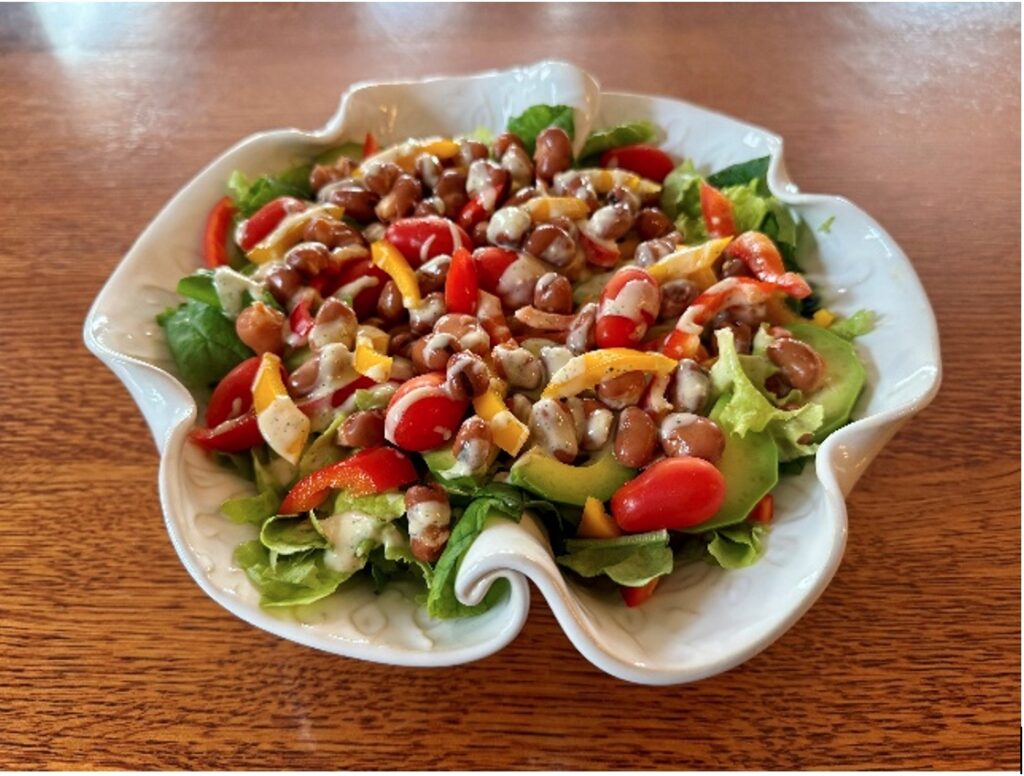
Topping off a leafy green salad with fava beans is a delicious way to enhance it, adding substance with a boost of protein. In the salad pictured above, a hydroponically grown salad mix with spinach and arugula is complemented by avocado, fresh peppers, canned fava beans, and a tahini-lemon-dill dressing. The salad remains equally filling and flavorful with fresh or roasted fava beans, which contribute a nutty flavor and satisfying crunch.
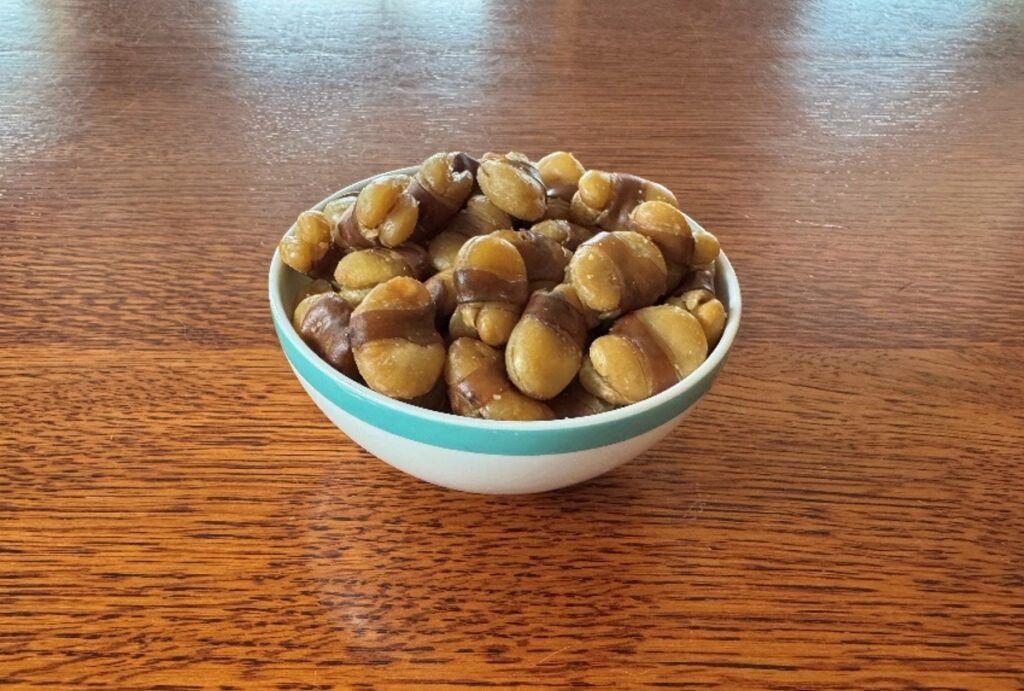
Roasted fava beans are a healthy snack that can be enjoyed on the trail or between meals as a quick pick-me-up, offering a nutritious option to help maintain your energy levels.
The adaptability of fava beans allows for them to be used in easy substitutions with various types of beans. Scroll on down to find a chili recipe featuring fava beans. This chili not only showcases their unique flavor, but it is also a hearty and satisfying meal in one bowl. To create your own version of the recipe, change it up by adding your favorite game meats, vegetables, and spices.
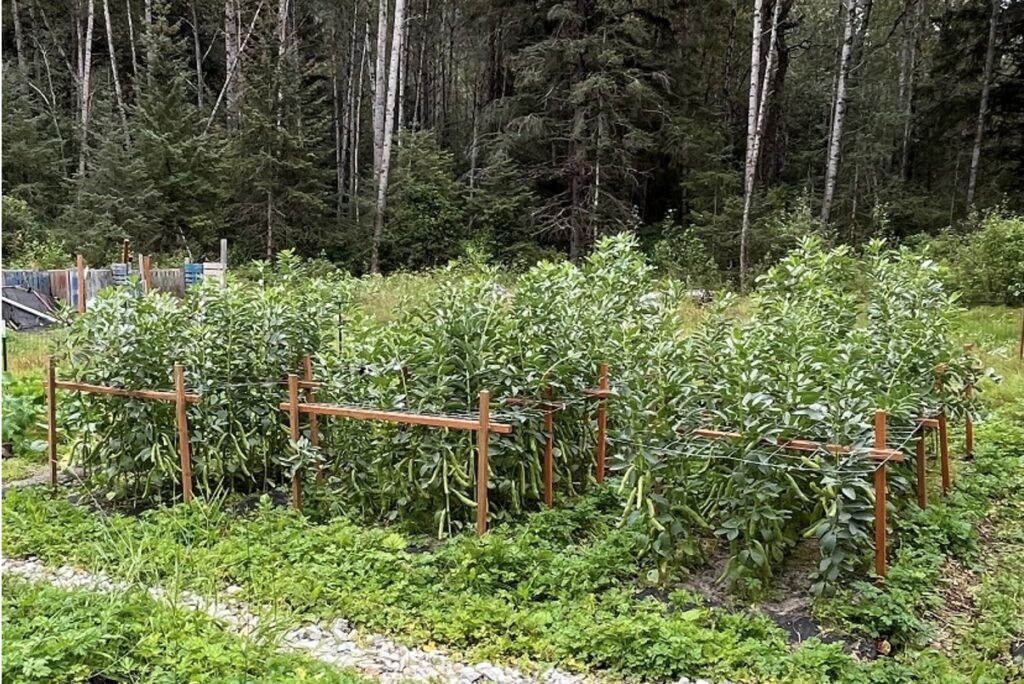
If you are interested in growing fava beans, there is still time to acquire your seeds and prepare for planting.
Skip Eliott began cultivating fava beans in the Dyea area of Skagway in 1976. He noted that England has a long-standing tradition of growing fava beans, known there as broad beans, and he observed many similarities between the English maritime climate and that of Southeast Alaska. He has achieved remarkable success with his crops and believes that fava beans are exceptionally resilient and tolerant of cold weather.
His target date for planting his favas is May 7 every year, regardless of soil temperature. He says he plants them directly in the ground in a raised bed that measures 4 feet by 12 feet. Skip puts three rows in the four-foot-wide bed, planting each seed six inches apart. He plants only one seed in each hole, around 1 to 2 inches deep, and has a 90% germination rate. The bed is maintained using no-till gardening techniques, and fabric is used to control weeds. He also installs a horizontal trellis with a 6-inch by 6-inch mesh about 2½ feet above the bed to support the stalk as it grows.
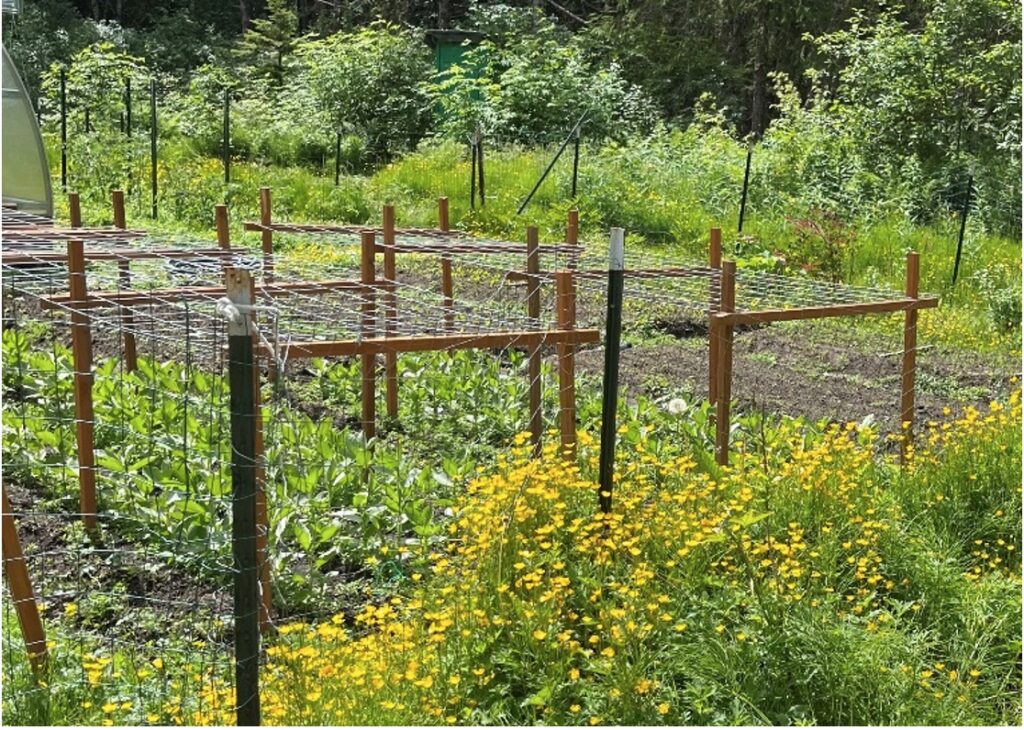
Skip says he enjoys spreading the word about how delicious fava beans are and how well they adapt to some of Alaska’s microclimates. He added that fava beans “are a great vegetable, and you don’t have to do anything to them. They put out blossoms that smell great and have a beautiful white flower. The bugs get into the flower sometimes, but the pests don’t seem to affect the plant. I have two harvests. The early favas taste the best. When they get ripe, the pods start to brown, and that is when the favas are sweet. I harvest for the first time in August, leaving about a third of the pods behind, and then I harvest again in September. You can even get a third harvest from them.”
He exclusively plants Vroma fava beans due to their shorter growing season and high yields. Skip estimates that two raised beds, each measuring 4 feet by 12 feet, provide more than enough fava beans to meet the annual legume needs of two people.
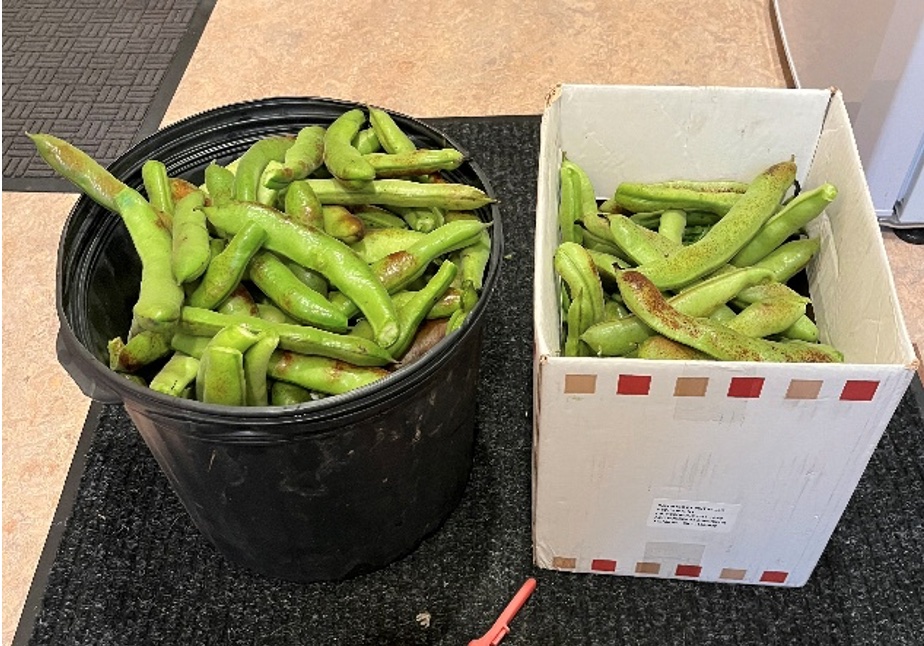
After harvesting the fava beans, Skip enjoys eating them when they are fresh. Most people remove the thick hull from fava beans before consuming them from the pod. He removes the beans from the pod but leaves the hull intact.
For long-term storage, he removes the pods, blanches the fava beans in boiling water for about four minutes, dries them, and then freezes them in pint-sized bags. Skip does not remove the hulls from the frozen favas, noting that he enjoys the texture, which he compares to eating kernels of corn. He simply warms the frozen favas, serves them with butter, and also adds them to soups.
“They are firm with a nutty taste and go with anything,” Skip stated as he described fava beans. He went on to say that they are “dense with lots of great texture.”
At the end of the season, he uses scissors to cut the stalk of the fava beans, transferring them to his compost, leaving the roots intact. Skip mentioned that it is beneficial for the bed to retain the roots because, “The roots have nodules, where bacteria that fix nitrogen in the soil reside.” This process enhances soil fertility, making it more productive for future crops. By maintaining these roots, he ensures that the beneficial bacteria continue to thrive and contribute to a healthier ecosystem in his garden.
After hearing numerous positive discussions about fava beans at the Chilkat Valley Gardening Conference and learning about effective gardening techniques from Skip Elliott, we will include them in our garden this summer. A packet of Vroma fava beans has been added to our seed order for the season, and I eagerly await the last of the snow to melt and the soil to warm. With visions of lush green stalks thriving in the garden and hopes for a bountiful harvest, I look forward to incorporating fava beans into new culinary options from the garden to the table.
Until that time, here’s a fava bean chili recipe to keep you warm as we wait for the last of the snow to melt.
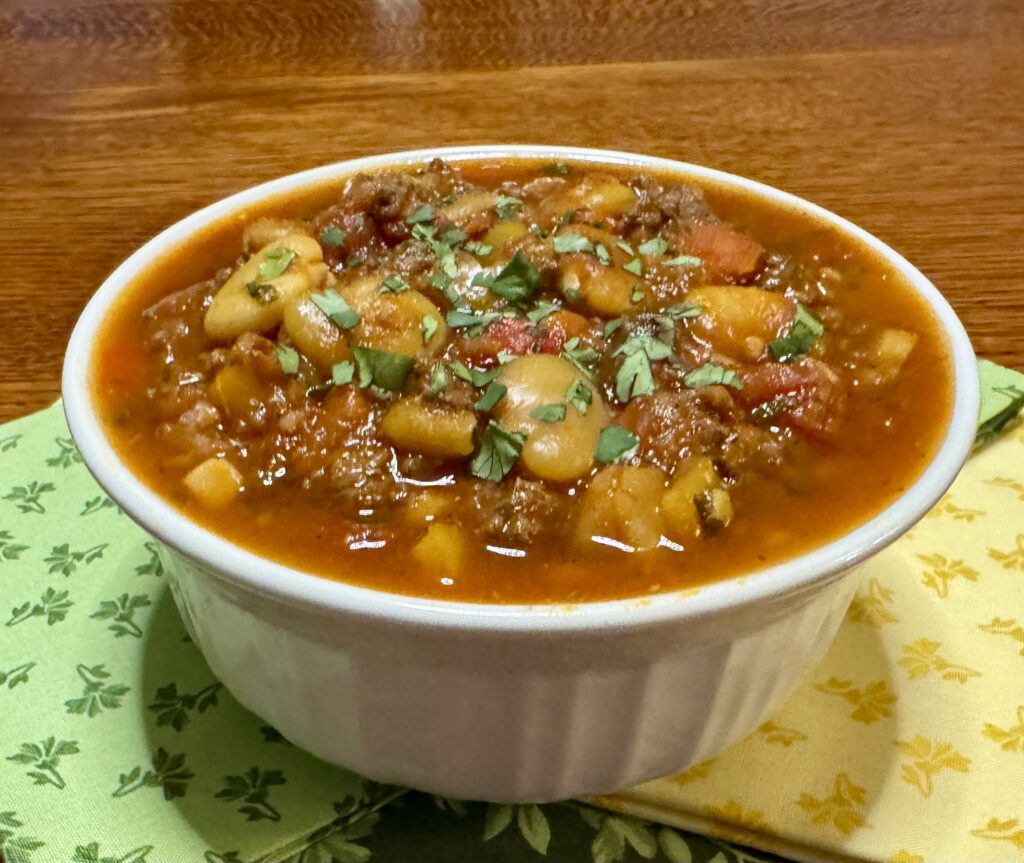
Fava Bean Chili
Ingredients:
1 to 1 ½ pounds of game meat (or substitute beef)
1 pint bone broth (or substitute stock or bouillon)
8 ounces dried fava beans (or substitute 2 each 14-ounce cans of fava beans)
1 6-ounce can of tomato paste
1 large yellow onion, diced
1 garlic head, minced
2 to 3 large bell peppers, diced
12 to 16 ounces of tomatoes, diced (or substitute one 14-ounce can of diced tomatoes)
8 tablespoons of butter
3 teaspoons salt, divided (more or less to taste)
2 teaspoons black pepper, divided (more or less to taste)
1 tablespoon chili powder (more or less to taste)
1 tablespoon ground cumin (more or less to taste)
1 teaspoon crushed red pepper flakes (more or less to taste)
½ teaspoon cayenne pepper (more or less to taste)
For garnish:
1 bunch of cilantro, finely chopped (or substitute parsley)
4 ounces of cheddar cheese, if desired
Preparation Time: ½ to 1 hour depending on if dried or canned fava beans are used.
Simmering Time: 30 minutes to 1 1/2 hours. Fava beans require 40 to 50 minutes simmering time in addition to the chili’s simmering time.
Servings: Approximately 10
Note: Double batches make excellent leftovers for the freezer.
Preparation:
Dried fava bean preparation is as follows:
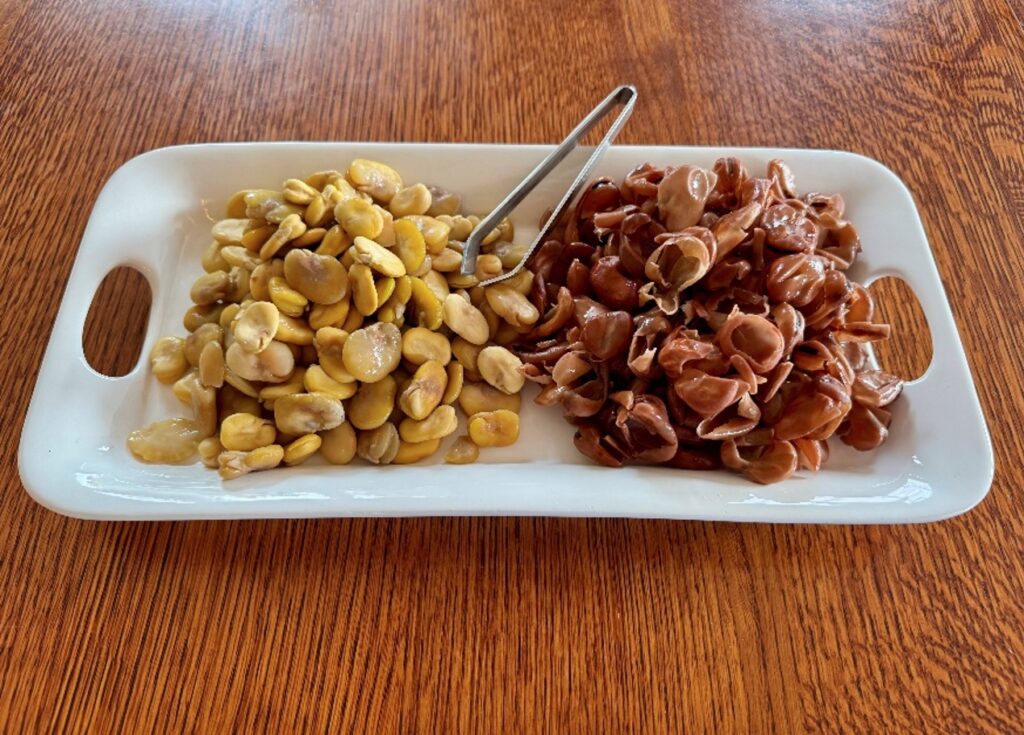
Soak: Prepare the dried fava beans by soaking them in water overnight. Alternatively, you can bring 4 cups of water to a boil and add the fava beans, continuing to boil for 10 minutes. Then remove from heat and drain the fava beans. Add cool water to the fava beans to bring them to room temperature. Then drain and rinse the fava beans.
Remove the hulls: To remove the hull, pinch the fava bean. This process requires a significant commitment of time and can take up to half and hour. Some hulls may be particularly tough to remove, necessitating more force A fishbone tweezer or crab fork can be useful for breaking open the tougher hulls.
Cook the fava beans: Place the hulled fava beans in a large pot over high heat with approximately 8 cups of water and 1 teaspoon of salt. Bring it to a boil, then turn it down to a simmer. Simmer for 40 to 50 minutes until the fava beans start to become tender, but not soggy.
Drain: Remove the fava beans from the water and set aside.
Chili Preparation:
Melt 2 tablespoons of butter in a pan on medium heat, add the game, and season with 1 teaspoon of salt and pepper each. Stir occasionally as the meat browns. When thoroughly cooked, remove from the heat and set aside.
In a large pot, melt the remaining 6 tablespoons of butter over medium heat. Then add the diced onions and cook, stirring frequently, until the onions start to caramelize. Add the garlic and stir for one to two minutes until the garlic starts to becomes aromatic and become translucent.
Add the bell peppers and stir, allowing them to cook for two to three minutes until they start to soften. Then add the diced tomatoes and stir until well incorporated.
The next step is to add the tomato paste, bone broth, and spices and stir until combined.
Finally, add the browned meat and fava beans. If needed, add water to the desired consistency.
Bring the chili up to a boil, then turn it down and simmer for 20 to 30 minutes until flavors combine.
Taste the chili and adjust the seasoning as desired. Then garnish with cilantro or parsley and cheese if desired.
Enjoy this delicious chili variation featuring fava beans!
Brenda Josephson is a Haines resident. She holds degrees in Culinary Arts and Food Business Leadership from the Culinary Institute of America, Hyde Park, New York. She enjoys spending time fishing, foraging, and savoring Alaska’s abundance of natural and wild foods with her family.

Sometimes all it takes to incorporate a new healthy food is for someone to write a good article. Definitely trying this!
Thanks Brenda, another great article. I’d never heard of Fava Beans before and growing up in the interior, I thought I knew all the hardy vegetables that do well in Alaska. I think we’ll try these . . . . a good addition to our garden.
the pods of fava beans are tasty and can be cooked like green beans; the top of the plant where flowers end and tender leaves are excellent for stir fry and soups; when the plants are young, at 8-10 inches tall, the tops can be picked are are super delicious in soups much like green pea shoots. In some Asian countries the young fava plant tops are used as vegetable greens. The removal of the tops also encourage multiple branches to increase yields. Hulled fava beans are excellent for stir fry with meat and eggs or soups; for some reason hulled fava beans are also excellent with swiss chard in soups; fermented fava beans are made into sauce; dried fava beans without soaking can be directly boiled for 8-10 minutes then dried as snack munchies…
dry fava plants after harvest are excellent nutritious fodder for goats, donkeys, horses and cattle